
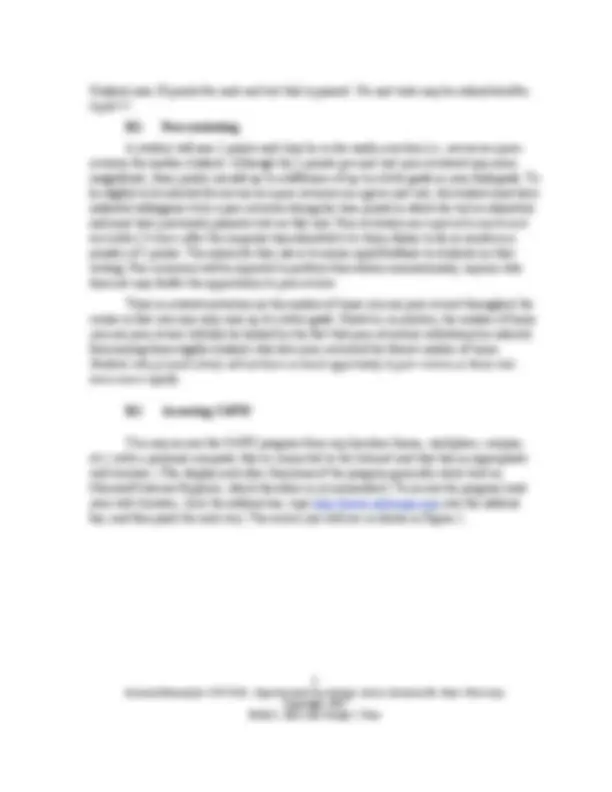
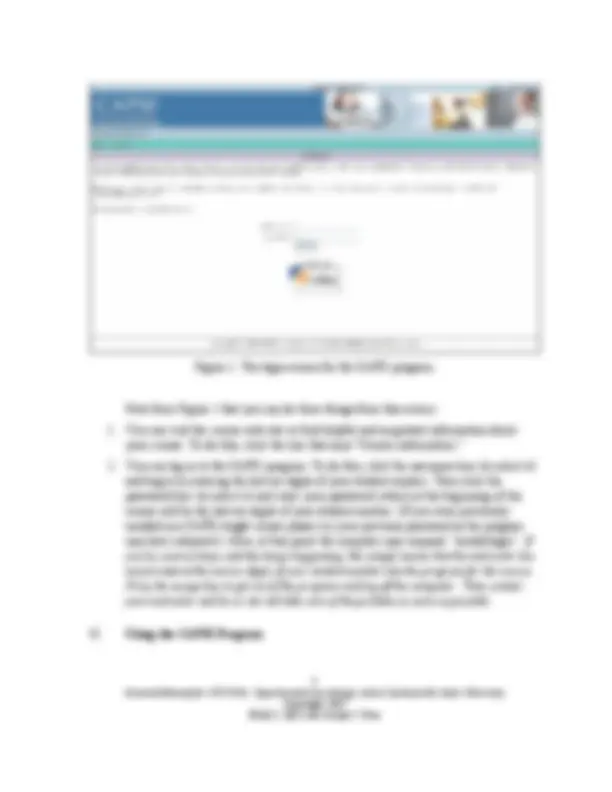

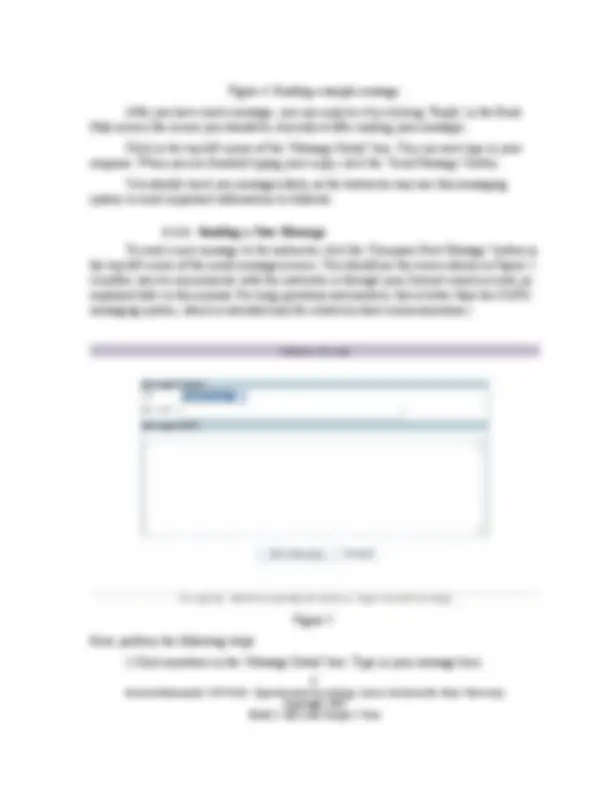
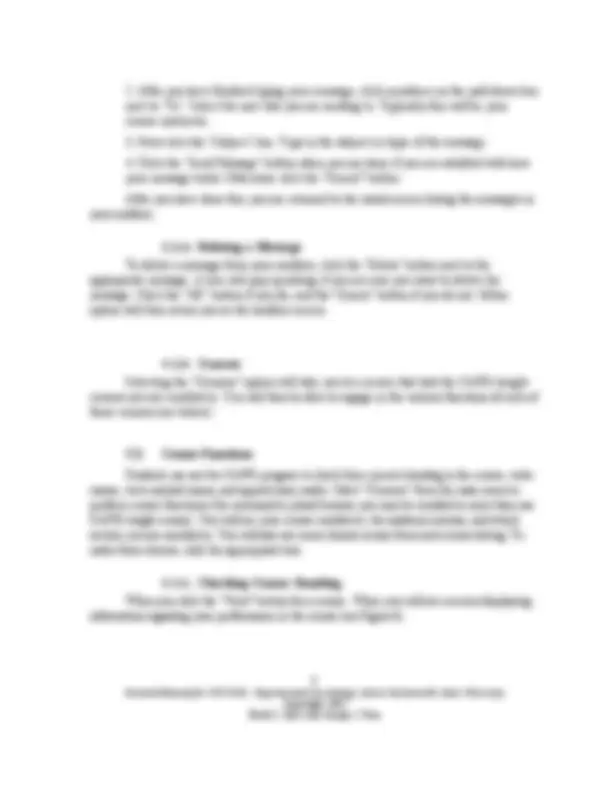
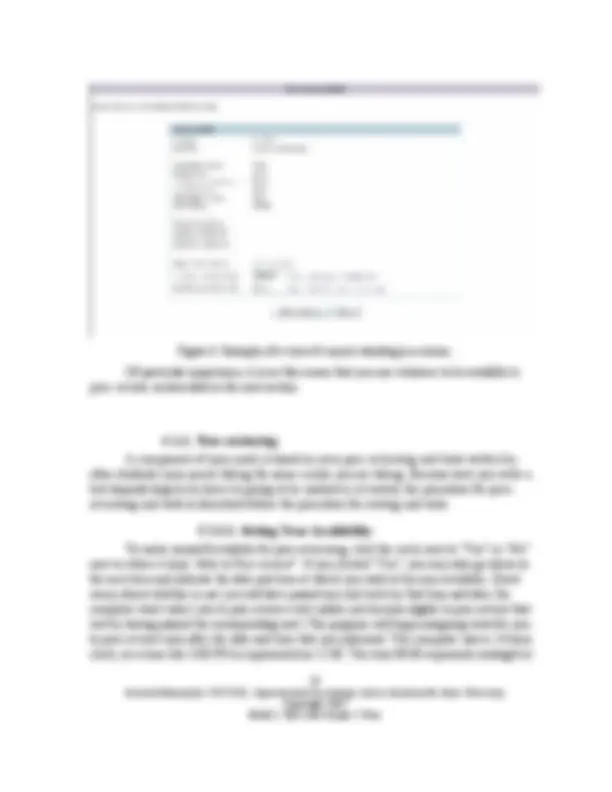

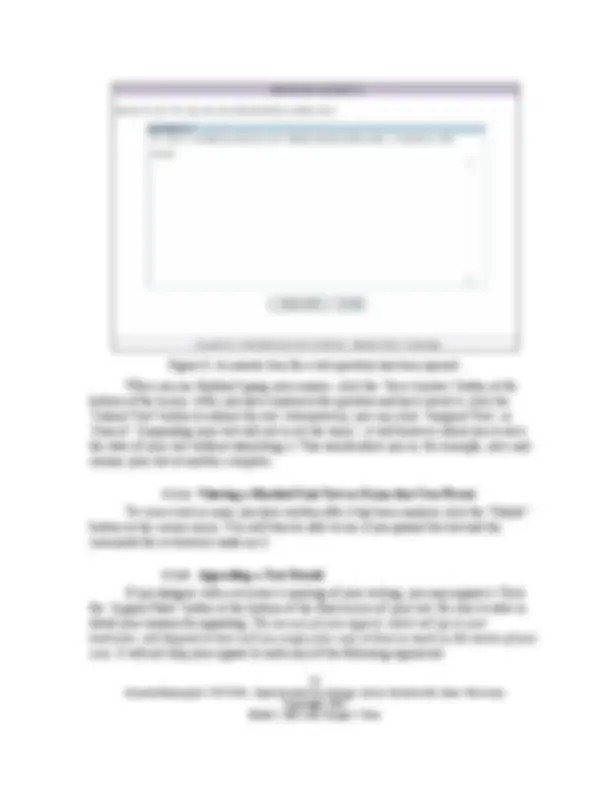
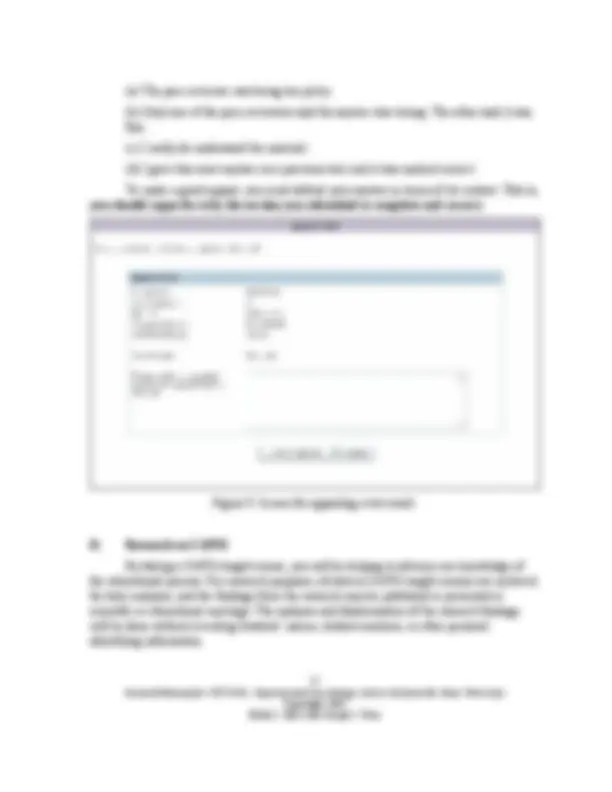


Study with the several resources on Docsity

Earn points by helping other students or get them with a premium plan


Prepare for your exams
Study with the several resources on Docsity

Earn points to download
Earn points by helping other students or get them with a premium plan
Community
Ask the community for help and clear up your study doubts
Discover the best universities in your country according to Docsity users
Free resources
Download our free guides on studying techniques, anxiety management strategies, and thesis advice from Docsity tutors
Material Type: Lab; Class: Research Methods; Subject: Psychology (PSY); University: Jacksonville State University; Term: Unknown 2007;
Typology: Lab Reports
1 / 17

This page cannot be seen from the preview
Don't miss anything!










General Manual for PSY 310L: Experimental Psychology Lab at Jacksonville State University. Copyright 2007 1
General Manual for PSY 310L: Experimental Psychology Lab at Jacksonville State University. Copyright 2007 2 A. Teaching Method & Goals Your instructor, Dr. Eyre, uses a teaching method known as Personalized System of Instruction (PSI). Originally developed by the behavioral psychologist Fred S. Keller, and hence also known as the "Keller Plan," PSI is based on learning principles. A computer program facilitates course administration; hence, the version of PSI used here is termed Computer-Aided Personalized System of Instruction (CAPSI). The goal of teaching courses using CAPSI is that students are able to think, talk, and write knowledgeably about the course material. The question-answer mastery procedure is designed to help students achieve this type of proficiency. B. Tests and Accessing the CAPS I Program B. 1. Unit tests Unit test is the generic name used in CAPSI to indicate the material that you will be submitting. In this class, the first unit will be the only one with multiple questions. In Units 2 to 7 , you will be simply submitting the various parts of your research paper. Unit tests may be taken at any time using a computer connected to the Internet. (Information on which computers to use and how to use them is provided in this manual under the section Using the CAPSI Program .) Tests will be evaluated by the instructor, an upper-level psychology student mentor, or two peer-reviewers - - i.e., students who have previously passed a test on that unit (see below). For Unit 1 - The study questions are of the short-essay type : it is important that students be able to answer them in clear English sentences. M any of the answers to the questions for Unit 1 (which is on the course procedures) are contained in this manual. A student passes a test on a unit by demonstrating mastery of the material in the unit. For the first unit test, this means that the student has completely and correctly answered the unit test question. For Units 2 to 7 – For these units mastery means that the submission is complete and correct in both content and APA style. Unit tests must be taken in numerical order, and (after Unit 1 ) students may not take a test on a given unit until they have passed a test on the previous unit. This ensures that students will have the necessary background to master each section of the research paper, since each section builds systematically on the previous sections. There is no penalty for not passing a unit test. You simply revise your paper and request another unit test and resubmit your paper for review. There is no limit on the number of attempts permitted on any unit.
General Manual for PSY 310L: Experimental Psychology Lab at Jacksonville State University. Copyright 2007 4 Figure 1. The login screen for the CAPSI program. Note from Figure 1 that you can do three things from this screen:
General Manual for PSY 310L: Experimental Psychology Lab at Jacksonville State University. Copyright 2007 5 C. 1. Main Menu Commands When your instructor has entered the last six digits of your student number into the program and you follow the above procedure, you will see a menu bar at the top of your “home” screen. (We'll call this the "main menu".) You may select any of the items in the main menu (which are fairly self-explanatory) by simply clicking the chosen item. Do not be afraid to experiment with this just to see what will happen. C. 1. 1. Changing Your Password One of the choices in the main menu is "Change Password." This choice permits you to change your password, which you should do as soon as possible. Your password may be any combination of letters and digits, up to eight characters. No one but you should know your password because an unscrupulous person could use it to get into your account. That person might then find out confidential information about your performance in the course or do any of the functions below (e.g., send out messages, write tests, peer-review tests) in your name, leaving you responsible for any problems he or she may have caused. To change your password, select Change Password from the main menu. A box will appear asking for your current password. See Figure 2. Figure 2. The screen for changing your password. Type in your current password, new password, and then re-enter your new password (to make sure the password you entered is the one you really want) in the appropriate fields. Then click “Update Password”.
General Manual for PSY 310L: Experimental Psychology Lab at Jacksonville State University. Copyright 2007 7 Figure 3. Your Message Box screen. C.2.2. Reading and Replying to a Message To read an Email message, click the ‘View’ button next to the message. You will see the text of the message, along with the header information you saw in the previous screen (with the exception of ‘Read’).
General Manual for PSY 310L: Experimental Psychology Lab at Jacksonville State University. Copyright 2007 8 Figure 4. Reading a sample message. After you have read a message, you can reply to it by clicking ‘Reply’ in the Read Mail screen (the screen you should be currently at after reading your message). Click in the top left corner of the ‘Message Detail’ box. You can now type in your response. When you are finished typing your reply, click the ‘Send Message’ button. You should check you messages daily, as the Instructor may use this messaging system to send important information to students. C.2.3. Sending a New Message To send a new message to the instructor click the ‘Compose New Message’ button in the top left corner of the email messages screen. You should see the screen shown in Figure 5. (Another way to communicate with the instructor is through your Internet email account, as explained later in this manual. For long questions and answers, this is better than the CAPSI messaging system, which is intended only for relatively short communications.) Figure 5. Now, perform the following steps: 1.Click anywhere in the ‘Message Detail’ box. Type in your message here.
General Manual for PSY 310L: Experimental Psychology Lab at Jacksonville State University. Copyright 2007 10 Figure 6. Example of a view of current standing in a course. Of particular importance, it is on this screen that you can volunteer to be available to peer - review, as described in the next section. C.3.2. Peer-reviewing A component of your mark is based on your peer-reviewing unit tests written by other students (your peers) taking the same course you are taking. Because how you write a test depends largely on how it is going to be marked or reviewed, the procedure for peer- reviewing unit tests is described before the procedure for writing unit tests. C.3.2.1. Setting Your Availability To make yourself available for peer-reviewing, click the circle next to “Yes” or “No” next to where it says ‘Able to Peer-review”. If you clicked "Yes", you may also go down to the next item and indicate the date and time at which you wish to become available. (Don't worry about whether or not you will have passed any unit tests by that time and date; the computer won't select you to peer-review a test unless you become eligible to peer-review that test by having passed the corresponding unit.) The program will begin assigning tests for you to peer-review only after the date and time that you indicated. The computer uses a 24-hour clock, so a time like 3:00 PM is represented as 15:00. The time 00:00 represents midnight at
General Manual for PSY 310L: Experimental Psychology Lab at Jacksonville State University. Copyright 2007 11 the beginning of the date indicated, whereas 24:00 indicates midnight at the beginning of the following day. To avoid confusion, it is best not to use these times. The time 23:59 is the highest value that should be entered and 00:01 is the lowest value that should be entered. If you do not indicate a date or time at which you will become available, the program will assume that you are available right away, and may send you a test to review at any time. Whenever you change your availability to peer-review, be sure to check to see if a test was sent for you to peer-review just before you changed your availability (or just as you were changing it). This is important, as students have sometimes missed tests assigned to them because a test was sent a moment or so after they checked for one. One very important point regarding changing your availability to peer-review: You must press click the “Save Changes’ button or the change will not be saved. If you click any other choice, or simply close the program, you will leave the current-status screen but the change will not be made. IM PORTANT: You are available to peer-review continuously from the date and time on which you agreed to become available until you change your availability. You are not signed off automatically after 24 hours. C.3.2.2. Checking for Tests and Viewing Answers If you signed on to be a peer-reviewer, you should check for a test to peer-review at least once during the time 24-hour limit for marking tests. You can check for tests by clicking the ‘Review’ button directly across from it. By default, you will be brought to a screen that lists tests that you previously reviewed as well as current tests submitted to you to review. To restrict this view either just to current or just to previous tests, click the pull-down box at the far right of the screen and then select either “Current” or “Previous.” If a test has been assigned to you to review, you will see the date and time it was submitted. To see the questions, click “Mark Test”. A screen will appear showing the questions. Select a question and click the ‘Comment’ button next to it to view the full question and the student’s answer. There is also a box for entering your comments on the student’s answer. C.3.2.3. How to Peer-review The comments you make on students’ writing should be respectful, constructive, and non-punitive. However, as stated earlier, the submitted section must be complete and correct before a pass result can be given. If the answer to a question is complete and correct, enter a comment and click the box next to “Displays Mastery.” A small checkmark will appear in the box. If the question is incorrect or incomplete in some way, do NOT click the “Displays Mastery” button (leave it unchecked). To save the comments that you have typed for a particular answer, and the
General Manual for PSY 310L: Experimental Psychology Lab at Jacksonville State University. Copyright 2007 13 To write a test on your current unit, click the “Test” button for the course. A box will appear advising you that there is a time limit for the unit test and will ask you to confirm that you want to start the unit test now. Remember : when writing a unit test you have a one-hour time limit in which to submit the test and receive credit. You may check the amount of time remaining by clicking the line that says, “Click here to view current time” on the initial screen listing the test questions (which you will return to each time you finish answering an individual question). When you get the test, you will see the first part of the selected questions on the screen (see Figure 7). You may answer the questions in any order by clicking the “Answer” button next to the question. After you select a question, will see a window in which to type your answer (see Figure 8). Figure 7. An example screen showing that a test has been started.
General Manual for PSY 310L: Experimental Psychology Lab at Jacksonville State University. Copyright 2007 14 Figure 8. An answer box for a test question has been opened. When you are finished typing your answer, click the ‘Save Answer’ button at the bottom of the screen. After you have answered the question and have saved it, click the ‘Submit Test’ button to submit the test. Alternatively, you can click ‘Suspend Test’, or ‘Cancel’. Suspending your test will not re-set the timer – it will however allow you to save the state of your test without submitting it. This would allow you to, for example, save and resume your test at another computer. C.3.4. Viewing a Marked Unit Test or Exam that You Wrote To view a test or exam you have written after it has been marked, click the “Marks” button on the course menu. You will then be able to see if you passed the test and the comments the reviewer(s) made on it. C.3.5. Appealing a Test Result If you disagree with a reviewer’s marking of your writing, you may appeal it. Click the ‘Appeal Mark’ button at the bottom of the final screen of your test. Be sure to state in detail your reasons for appealing. The success of your appeal, which will go to your instructor, will depend on how well you argue your case at least as much as the merits of your case. It will not help your appeal to make any of the following arguments:
General Manual for PSY 310L: Experimental Psychology Lab at Jacksonville State University. Copyright 2007 16 Some course procedures may differ somewhat in the same course from term to term, or from course to course in the same or different terms. The purpose of these variations will be to determine the relative merits of different educational procedures. At the end of the course, students will receive a statement explaining the major independent and dependent variables that will be examined in the context of their courses. E. Communicating with the Instructor via Internet Email In addition to the CAPSI messaging system, Internet email is a very effective way to communicate with the instructor. Your Internet email account is the best choice when you wish to send and receive relatively large messages. For example, it is best to use Internet email when asking the instructor questions that require detailed answers. Please include the course number you are writing in reference to as well as your CAPSI ID number in all email messages to the instructor. F. Dealing with Access Problems If you have successfully followed the access instructions in this manual, but encounter a situation in which the normal access procedures do not work, please do the following things.
General Manual for PSY 310L: Experimental Psychology Lab at Jacksonville State University. Copyright 2007 17 We would appreciate hearing what you think about this guide. At any time, please feel free to send us your comments and suggestions about what you liked, what you feel may be missing, and whether anything was not helpful at all. Our hope is to keep improving upon this guide so that future students may benefit from such information. Please send comments to heyre@jsu.edu. Thank you.